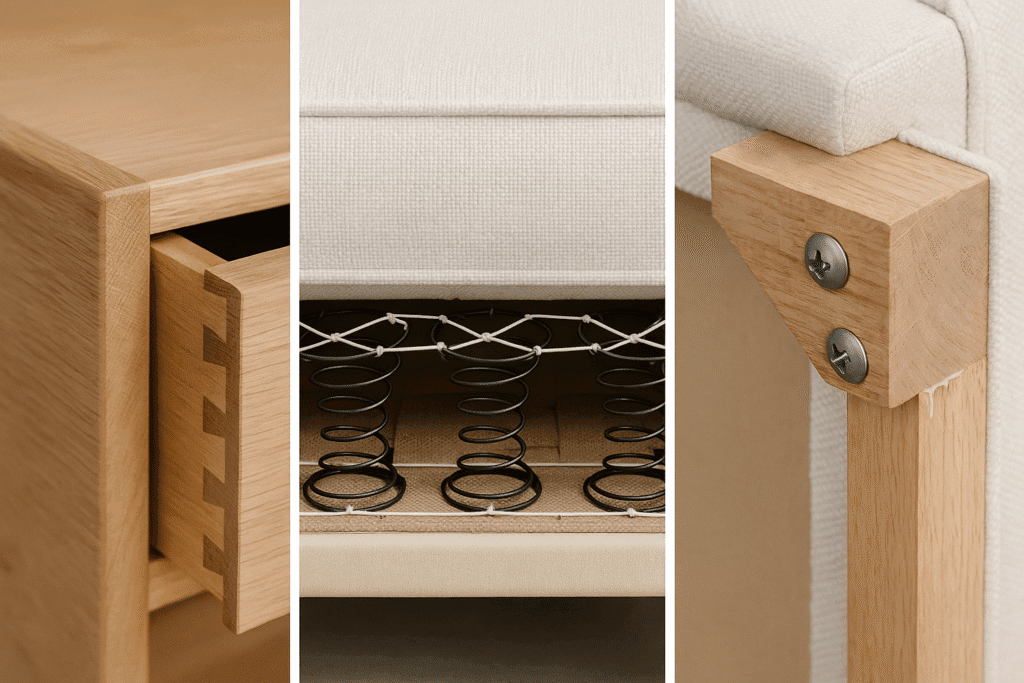
In our rapidly evolving era, one can easily be drawn in by the appeal of a modest cost. But when it comes to furniture for your home, a bargain might not always be the best value.
True value isn’t just about what you pay upfront; it’s about the longevity, quality and enduring performance of a piece.
Investing in durable furniture means less waste, fewer replacements and a home filled with pieces that stand the test of time. So, how can you spot genuine quality that goes far beyond the initial price tag?
Let’s explore the signs that expose genuine artistry.
Furniture Construction Matters: The Hidden Strengths
The real secrets of a furniture piece’s durability often lie beneath the surface, in how it’s built.
- Kiln-Dried Hardwood Frames: For sofas, armchairs and wooden case goods (like chests of drawers), a kiln-dried hardwood frame is the gold standard.
Kiln-drying removes moisture from the wood, preventing warping, cracking and bowing over time.
Softwoods like pine are cheaper but less durable, while engineered wood (like MDF or particle board) is a red flag for structural integrity, especially in load-bearing areas. - Reinforced Joints: How are the pieces put together? Look for indications of dovetail joints (for drawers), mortise and tenon or dowelled joints for strong, lasting connections.
Steer clear of furnishings primarily assembled with staples, nails or apparent adhesive, as these indicate inferior, less robust fabrication. Corner braces, adhered and fastened, greatly enhance the sturdiness of sofa frameworks. - Eight-Way Hand-Tied Springs: This is the pinnacle of sofa and armchair suspension systems. Eight-way hand-tied springs involve each coil being individually tied by hand in eight directions, creating a supremely supportive, even and durable seating experience.
It’s a labour-intensive process, reflecting higher quality and comfort that lasts decades. More budget-friendly options might use S-springs (sinuous wire) or webbing, which are acceptable for lighter use but won’t offer the same longevity or even support.
Foam Density & Fabric Fortitude: Comfort That Lasts
The feel of your furniture is just as important as its frame and these indicators speak volumes about its lifespan.
- High-Density Foam: For cushions, foam density is key to preventing sagging and maintaining comfort. High-density foam (often expressed in kg/m³ or lb/ft³) will regain its shape and provide consistent support for years.
Lower-density foams feel soft initially but quickly compress and break down. While you might not get an exact number, look for descriptions like “high-resiliency foam” or “premium density” rather than vague terms. - Fabric Martindale Rating: This is a crucial measure of a fabric’s durability, particularly for upholstery. The Martindale Rub Test measures a fabric’s durability, showing how many abrasive cycles it can withstand before noticeably breaking down.
- 10,000-15,000 rubs: Ideal for ornamental pieces or minimal household application.
- 20,000-25,000 rubs: Good for general domestic use (e.g., a family sofa).
- 30,000+ rubs: Heavy domestic use or commercial use. Always ask for or look for this rating, especially for high-traffic pieces.
The Assurance of a Warranty & Sustainable Value
Beyond the physical attributes, look for these markers of a reputable brand and long-term commitment.
- Comprehensive Warranties: A strong warranty acts as a manufacturer’s declaration of confidence in their item’s dependability.
Look for separate warranties on the frame (often 10-25 years or lifetime), springs (5-10 years) and cushions/fabric (1-5 years). A longer, more comprehensive warranty signals durability and a company willing to stand by its product. - Sustainable Sourcing: While sometimes perceived as adding to the price, sustainable sourcing often goes hand-in-hand with higher quality and ethical production.
This can include:- FSC-certified wood: It verifies the lumber is procured from environmentally sound forests.
- Recycled or up-cycled materials: Often chosen for their durability and reduced environmental impact.
- Ethical manufacturing processes: Companies committed to sustainability often have stricter quality controls. Investing in sustainably sourced furniture isn’t just good for the planet; it’s often a sign that a company prioritizes long-term value and responsible practices over cheap, disposable goods.
Ultimately, finding true value and durability in furniture requires a discerning eye and a willingness to look beyond the immediate appeal of a sale.
By understanding key construction methods, material quality indicators and the assurances offered by warranties and sustainable practices, you empower yourself to make informed decisions. You’ll not only create a more beautiful and comfortable home but also make enduring investments that you can enjoy for years, even decades, to come.
What’s the longest lasting piece of furniture you own and why do you think it’s endured?
